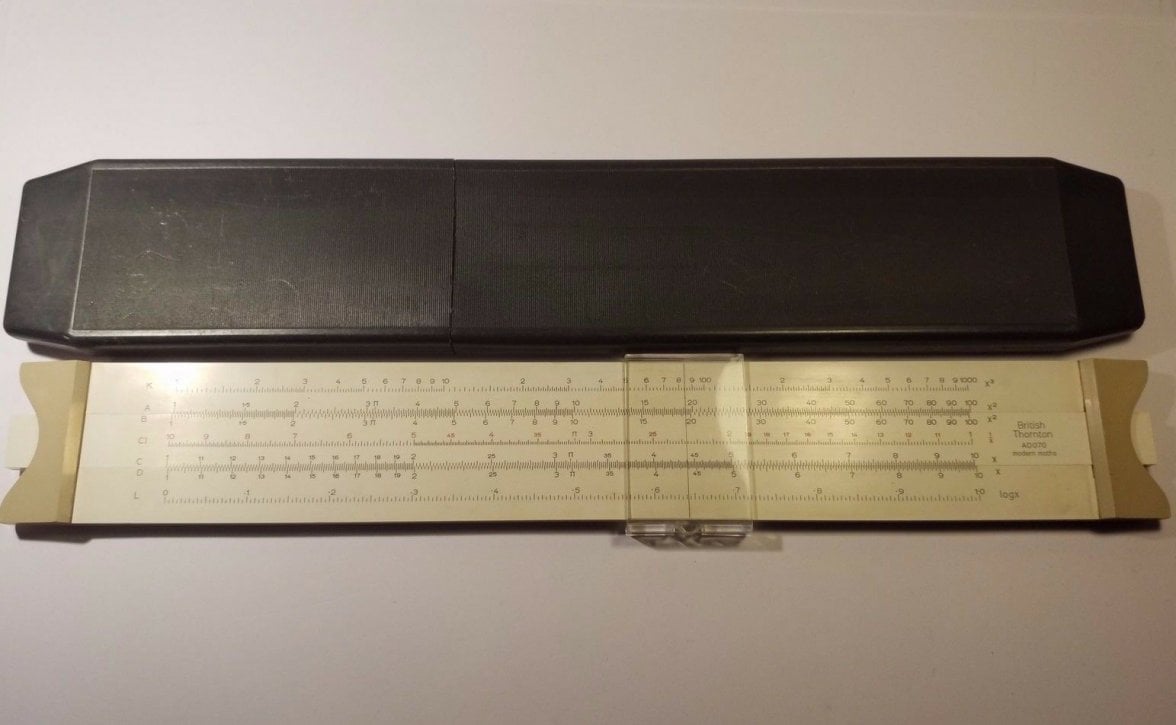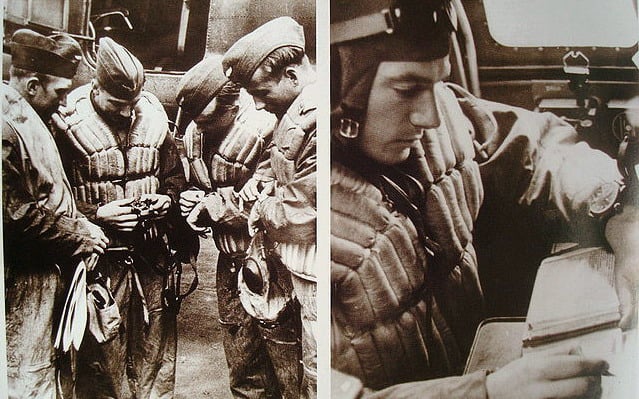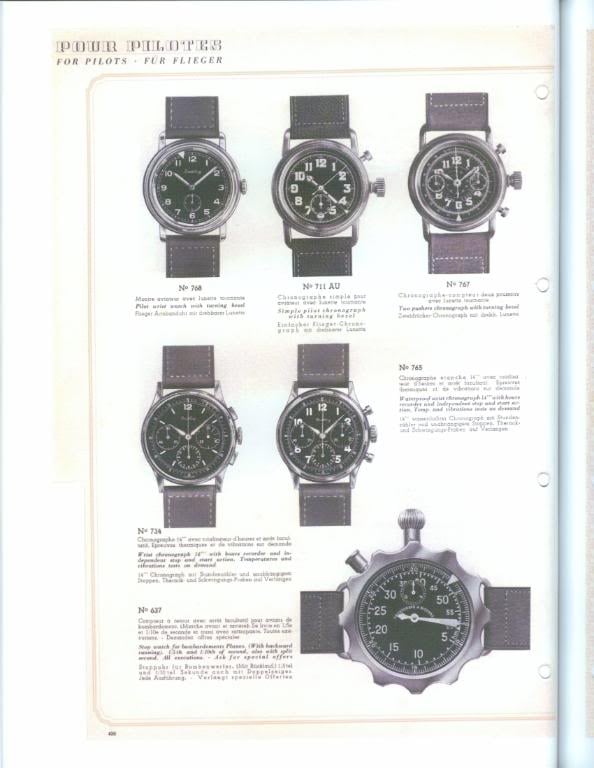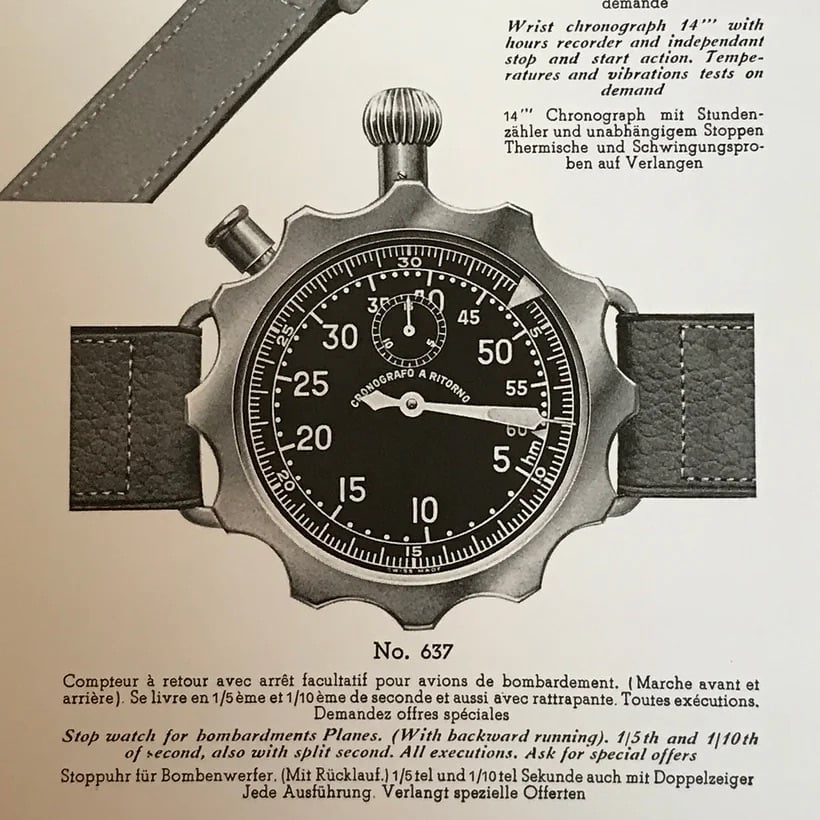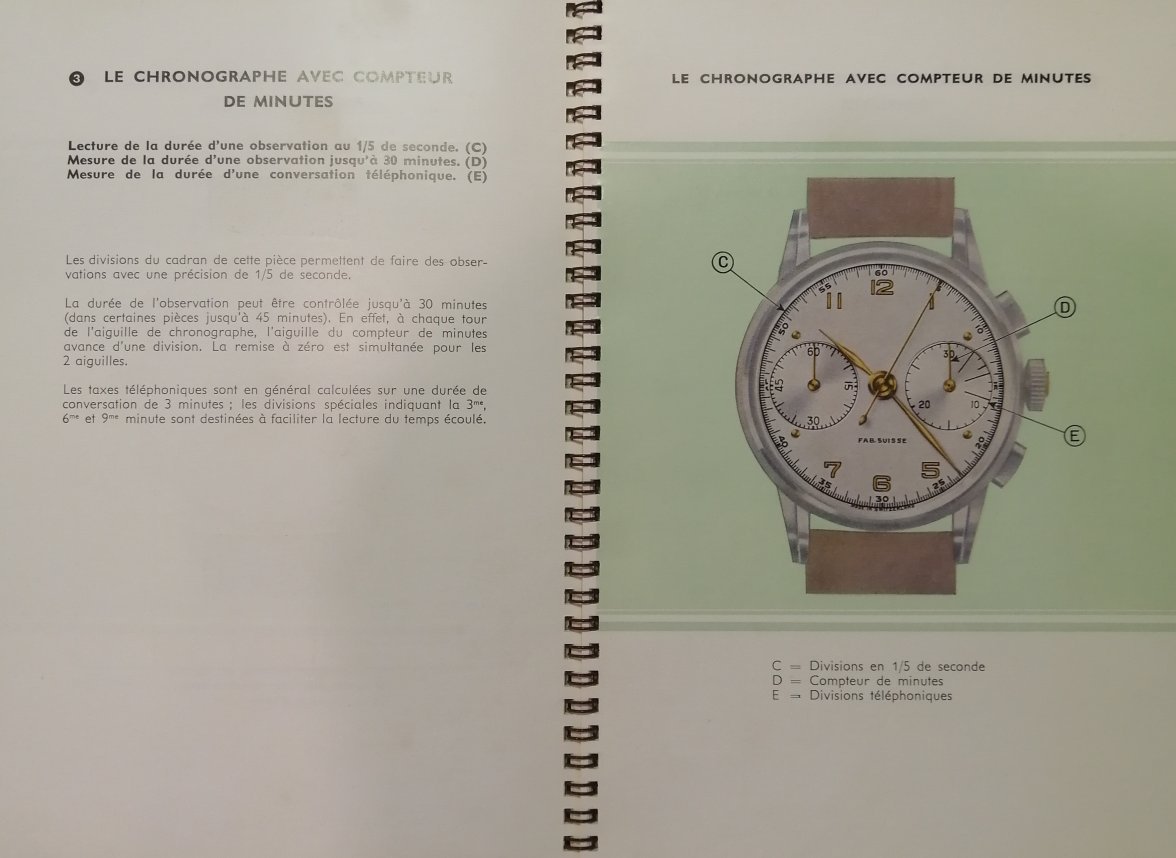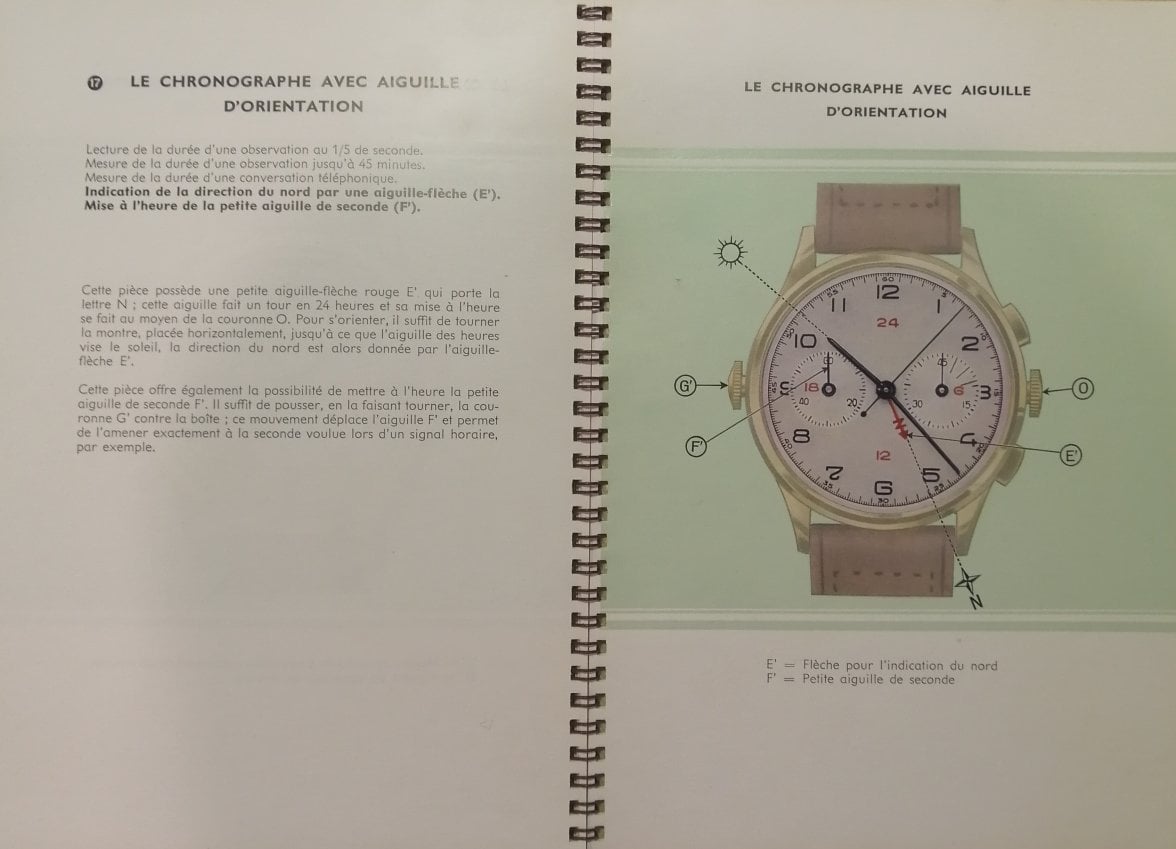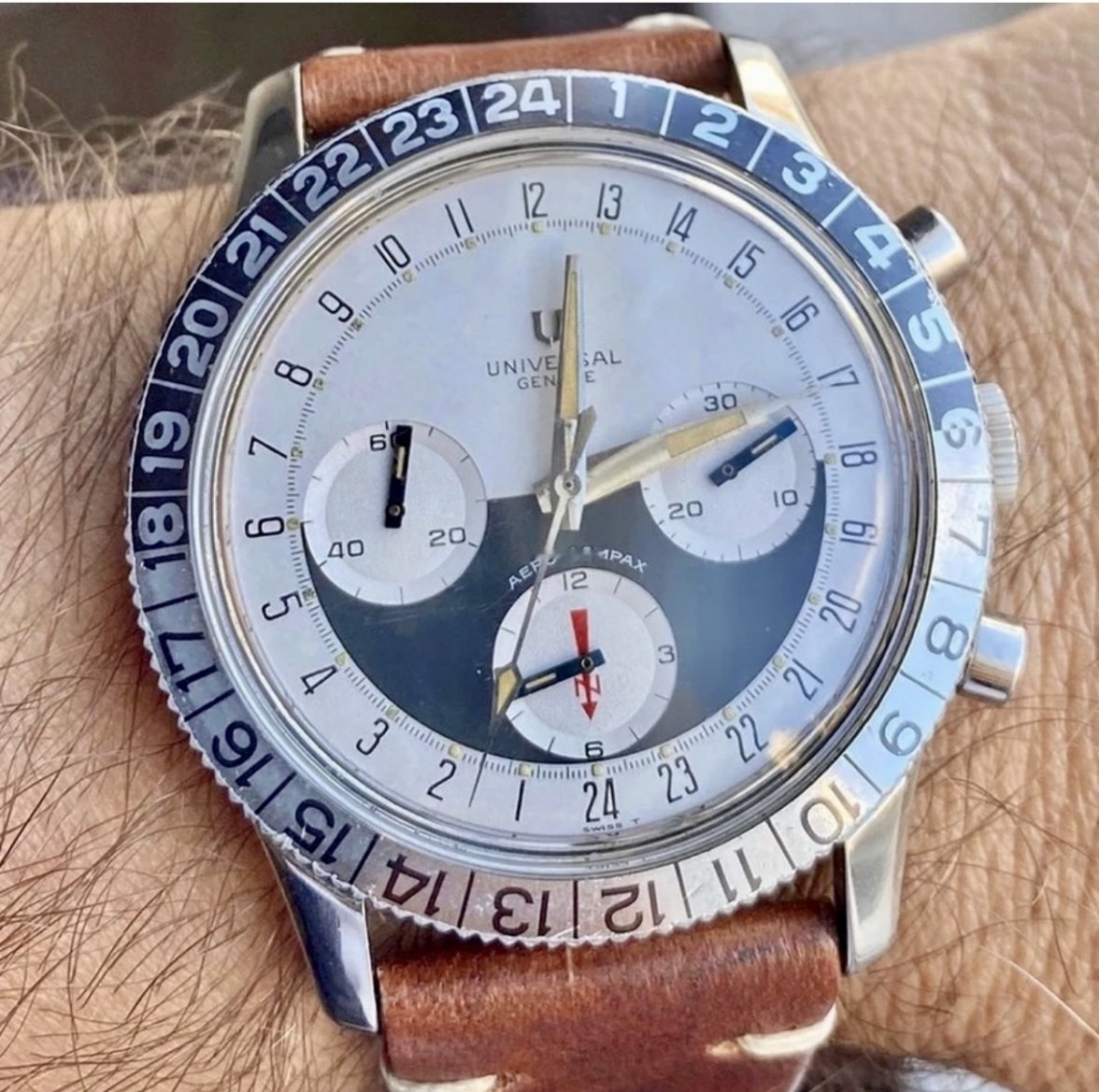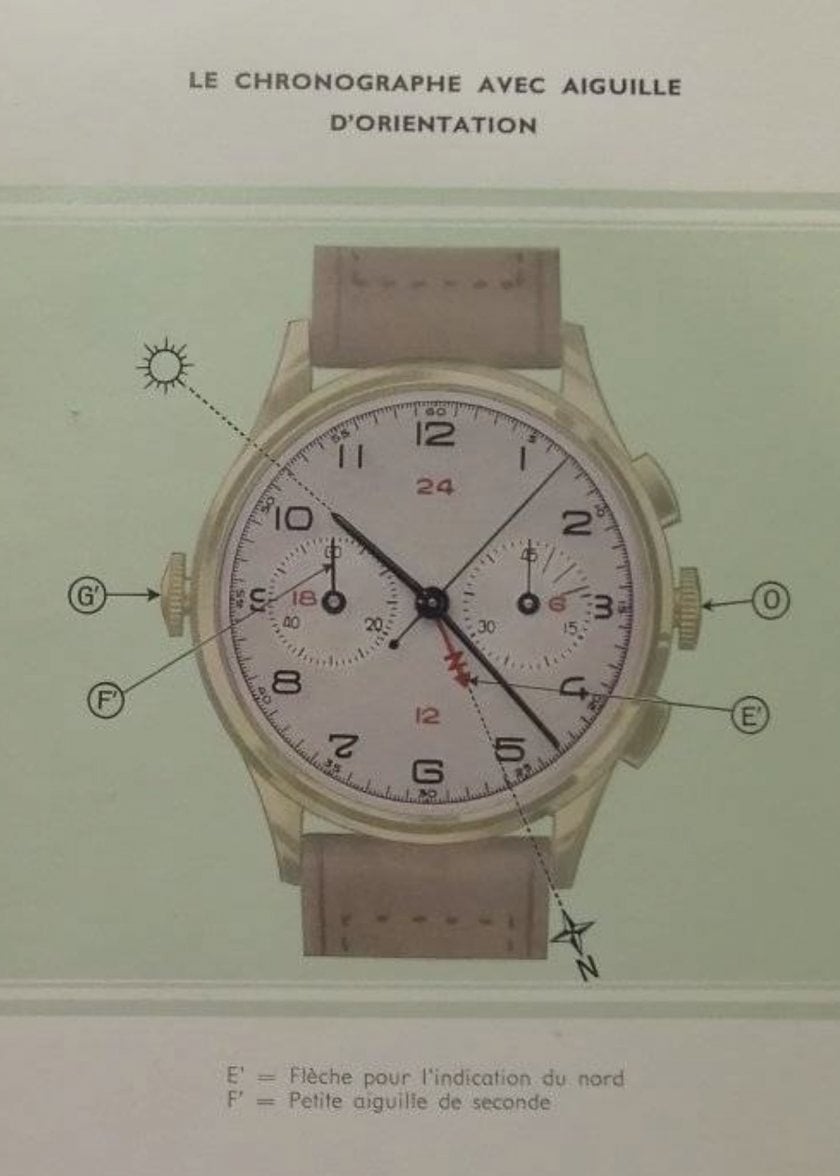3 Minute Marks on Pilot’s Chronographs: (Partially) Debunking Myths and (Some) Dead Reckoning
Omegafanman
·Never saw a written explanation of these 3min marks in a catalogue either. I have a leaflet from the Swiss watch industry (printed probably before 1970 or 1965) painstakingly explaining how to use every type of chrono under the sun - no mention of it, even if they are on the dials.
So it must have been very easy to use, self explanatory, and common to a few different countries. The telephone thingy fits the bill, other navigational use involving math or a specific and forgotten pilot duty... Not really. And as pilots do need phone calls, finding them on pilot watches is OK.
Alternatively, some military cronos of the era do not have them and they were designed for pilots (dodane xx, Heuer 1550, junghans j88). Some have them (auricoste xx) and share the same spec sheet. IMHO, if this simple functionality was not even specified, it was not really useful to a pilot working in a cockpit.
For me, telephone : 1 and navigation : 0.
@cvalue13 - thanks for this thread. Very good read and good contributions. Ref the comment above and having read everything today I think Navigation 0 might be an unfair score. The rule of 3 might apply to a number of things including navigation. In WW2 history I have seen lots of references to speed/time plotting in relation to getting on target and hitting the target. Avoiding detection and dropping bombs in the right place was key / not the flight time. Early in the war most night raid bombs dropped miles off target. Watches, chronographs / stopwatches all played a part (along with radio and radar positioning later in the war) on-board timing was very critical for that period. At most briefings they also sychronised watches. I have also been researching a very famous test pilot who used a Chronomat from 1946. Most of his famous flights did not need navigation as such but he did help resolve a lot of engineering issues which required detailed calculations - I suspect the 'calculator' aspect played a part in that. I cant work my fathers slide-rule so a lot of this is lost on me - but mechanical calculators like that did give us Concorde and Apollo :0)
.
Edited:
cvalue13
·@cvalue13 - thanks for this thread. Very good read and good contributions. Ref the comment above and having read everything today I think Navigation 0 might be an unfair score. The rule of 3 might apply to a number of things including navigation.
Thank you, and yes, I believe @S.H. either misspoke or misunderstood the thrust of this research to date.
There appear to be at least two different “3” related phenomena going on. On one hand, are those watches perhaps like @JimInOz and @STANDY posted, which appear to be fairly standard (let’s call them) dress chronographs for the “everyman” with nothing more than 3/6/9 demarcations added to the minute totalizer. I’ve agreed and for some time now been collecting evidence (like my Heuer post above) that the most apparent explanation is the timing of long distance calls in certain European countries during a period when charges were totaled in successive 3 minute blocks (making them essentially vestigial markings in the U.S. and many other countries without that charge structure).
Separately, at the other end of the spectrum (if you will) there is a different category of watch, marketed to pilots or even made specifically in response to military requisition requests for pilots, where the manufacturers have gone quite further than merely adding 3/6/9 emphasis on otherwise standard dial designs. In this second category, manufacturers did things like:
-> change the movements to have 15 rather than 30 minute totalizers (making them more legible for short increments measurement)
-> create a “big eye” minute totalizer (again to make them more legible)
-> denote only 3 minute increments on the minute totalizer (dispensing with the 5 minute marks altogether, and in effect again making the 3 minute increments more legible)
-> adding luminous hands to the minute totalizer
-> adding luminous plots to the 3-minute indices on the totalizer
There are some examples of these watches that have done all of the above, and for watches made for military pilot use only. I do not believe that manufactures went this far in order to help pilots time telephone calls, much less at from their cockpits and at night (this the legibility improvements).
The above are presented as two separate categories, and many such examples of those categories can be found. But then also there are more muddled examples that might not nearly fit. But muddled examples should be no surprise to us heeled in vintage watch oddities, especially in the 50s-70s. Manufacturers were better or worse at execution, or sometimes simply experimenting in their marketing, or any number of reasons there are at times exceptions to rules.
But for either category of watch, I’m still personally irked by the relative lack of primary documentation or explanations around what are currently mere deductive inferences on everyone’s part, myself included.
It’s funny how there appears to be a strong tendency in some to say “it’s not for pilots there’s no evidence for that, so it must be for phone calls” when there’s an equal amount of evidence for that.
In truth, there’s quite a lot of inference for both, but frustratingly little primary evidence for either. Though, we’re in this thread starting to compile more than can be found anywhere else.
cvalue13
·The rule of 3 might apply to a number of things including navigation. In WW2 history I have seen lots of references to speed/time plotting in relation to getting on target and hitting the target. Avoiding detection and dropping bombs in the right place was key / not the flight time. Early in the war most night raid bombs dropped miles off target. Watches, chronographs / stopwatches all played a part (along with radio and radar positioning later in the war) on-board timing was very critical for that period.
Thought I’d add that the universe war/post-war chronographs for navigating from the cockpit have many interesting examples relevant to this conversation. Here’s from the same Breitling catalogue from 1942 referenced earlier:
Note that this last example was a thigh worn stopwatch, rather large in size.
To your quoted point, there really can’t be any serious contention that chronograph watches weren’t critical equipment for pilots, used in navigation. The only remaining questions are whether in connection with navigation/piloting certain features we see had an intended use case.
M'Bob
·And how exactly is a pilot supposed to measure the number of yards they covered in three minutes. The tachymeter scale is precisely there for measuring speed, a pilot doesn't need the subdial for that. And there is nothing special about 3 or 6 minutes when it comes to the distance one travels. That part didn't make any sense to me. No pilot is going to set their speed to a particular value just so they can travel a certain distance in 3 minutes. Maybe there is something I'm missing, but the pilot explanation doesn't feel satisfying.
I think it would be good to search for period advertising. Maybe some of the manufacturers promoted the markings as a feature. Or maybe one could find a book from the 1930s. That would be much less speculative.
You know, at the very least, you could acknowledge the effort and time put into the original post in tandem with your disagreement.
S.H.
·@cvalue13
I found something definitive, I think. In another older leaflet from the Swiss industry printed in 1952 :
It says these 3min markers are dedicated to the timing of phone calls. I can provide a translation if you need it, I am at work right now.
Bonus track: a feature I never saw irl:
I found something definitive, I think. In another older leaflet from the Swiss industry printed in 1952 :
It says these 3min markers are dedicated to the timing of phone calls. I can provide a translation if you need it, I am at work right now.
Bonus track: a feature I never saw irl:
cvalue13
·I found something definitive, I think. In another older leaflet from the Swiss industry printed in 1952 :
Yes thank you for this version, and additional pages:
This is the same pamphlet that I’ve ordered (remind me, where is it in shipping), and discussed a bit earlier in the thread:
here, first brought to light by @DirtyDozen12 but in English:
https://omegaforums.net/threads/3-m...ome-dead-reckoning.138286/page-3#post-1881693
Here, where I note that the graphics are reproduced by the other only period material to reference the call and note the still frustrating lack of primary materials:
https://omegaforums.net/threads/3-m...ome-dead-reckoning.138286/page-3#post-1881693
And then for completeness here, too, is the post of the watchmakers book that appears to use drawings of the photos from the pamphlet you reference:
https://omegaforums.net/threads/3-m...ome-dead-reckoning.138286/page-3#post-1881639
In all, the pamphlet you’ve linked to is essentially the only period piece describing these “mere 3/6/9 emphasis” marks as being used for calls. I say it’s the “only” because the watchmaker’s book that also asserts this, I think, is clearly only copying and parroting these very pamphlet materials (the drawings in the watchmarker’s book are a trace of the watch photographed in the pamphlet).
I should soon receive a vintage English copy of this pamphlet (ordered over a week ago) and will look forward to posting its contents here!
Thank you very much for finding this non-English version, to add some further detail.
Omegafanman
·Would you mind please translating around the red arrow discussion?
This is a feature I’ve seen on a few watches from the mid-century, including the alternate dial version of my UG discussed in the original post:
I wonder if it is the old find North trick.... Bisect the angle between the hour hand and the twelve o'clock mark to find North. The exact middle of the angle between the 12 o'clock mark and the hour hand on your watch marks North, while the point directly across the face of the watch from it marks South.
MRC
·I wonder if it is the old find North trick.... Bisect the angle between the hour hand and the twelve o'clock mark to find North. The exact middle of the angle between the 12 o'clock mark and the hour hand on your watch marks North, while the point directly across the face of the watch from it marks South.
cvalue13
·I wonder if it is the old find North trick.... Bisect the angle between the hour hand and the twelve o'clock mark to find North. The exact middle of the angle between the 12 o'clock mark and the hour hand on your watch marks North, while the point directly across the face of the watch from it marks South.
It certainly seems it’s getting at something like that, though the graphic in the pamphlet suggests a different methodology:
Meanwhile, the UG version is a 24hr dial, so while I’ll admit to being dense on this topic it would seem that - regarding the identical time of day - between a 12hr and 24hr dial the hour hand is in different dial position.
cvalue13
·Also I’m just noticing the crown at “G” 👎
S.H.
·I'll try to translate it properly to something intelligible in English 😉 (I'm French) tonight. It is a way to use a watch like a compass, with a 24h hand, and a hacking second as a bonus, both controlled by a second crown. A little 🤨 if you ask me...
cvalue13
·I'll try to translate it properly to something intelligible in English 😉 (I'm French) tonight. It is a way to use a watch like a compass, with a 24h hand, and a hacking second as a bonus, both controlled by a second crown. A little 🤨 if you ask me...
Assuming we’re reviewing the same version of the pamphlet, I think by tonight I should be able to test your translation skills 😁
cvalue13
·I expect it could be used as a regular GMT in any time zone. And if used as a compass the offset from home time zone could be set to 1 hour during daylight saving, eliminating the difficult maths of subtracting the hour.
Thank you for attempting to help, but I’m confused
I’m almost certain the red “N” arrow is painted on the dial (in the same manner as the red 6, 12, 18, 24), and that this is a 3 hand watch (excluding the chrono totalizers), with a 12 hour movement.
But of course the extra crown suggests strongly I’m missing something!
S.H.
·Thank you for attempting to help, but I’m confused
I’m almost certain the red “N” arrow is painted on the dial (in the same manner as the red 6, 12, 18, 24), and that this is a 3 hand watch (excluding the chrono totalizers), with a 12 hour movement.
But of course the extra crown suggests strongly I’m missing something!
Roughly translated it says the red arrow hand with the N letter (E') is a 24H hand, settable by the crown O. To use as a compass, orient (horizontally) the watch so that the hour hand points towards the sun, North is then given by the red arrow.
Additionally, the second crown G' can stop and move the small seconds F' so that the watch can be set against some external signal.
Hope that helps. Here we have two different functions, the second crown has nothing to do with the 24h hand, I misread O for G the first time.
MRC
·Thank you for attempting to help, but I’m confused
I’m almost certain the red “N” arrow is painted on the dial (in the same manner as the red 6, 12, 18, 24), and that this is a 3 hand watch (excluding the chrono totalizers), with a 12 hour movement.
But of course the extra crown suggests strongly I’m missing something!
Lets try a Gedankenexperiment. When the 12-hour hand is at 12 where is North? It's directly behind us, not over our right shoulder. So the 'E' hand needs to be at 6 o'clock and therefore it's a moving hand not on the dial.
In case anyone finds one of these can I get my dibs in now?
cvalue13
·We need to know what the movement is. But I am basing my view that this is a drawing not a photograph and it's hard to tell the depth of the hands/paint. I think the red hand is a 24 hour, see that it is in the correct position relative to the hour hand, assuming 10:23 am. And the 6 12 18 24 marks are where they should be for a GMT. Then the 'G' crown sets the offset of the red hand to the 12-hour hand and that it's a regular GMT movement.
Lets try a Gedankenexperiment. When the 12-hour hand is at 12 where is North? It's directly behind us, not over our right shoulder. So the 'E' hand needs to be at 6 o'clock and therefore it's a moving hand not on the dial.
In case anyone finds one of these can I get my dibs in now?
It would be helpful to know the year of this version of the pamphlet; if it’s the 40s, like the watchmakers book, then the existence of an independent GMT/hand watch becomes dubious!
S.H.
·It would be helpful to know the year of this version of the pamphlet; if it’s the 40s, like the watchmakers book, then the existence of an independent GMT/hand watch becomes dubious!

